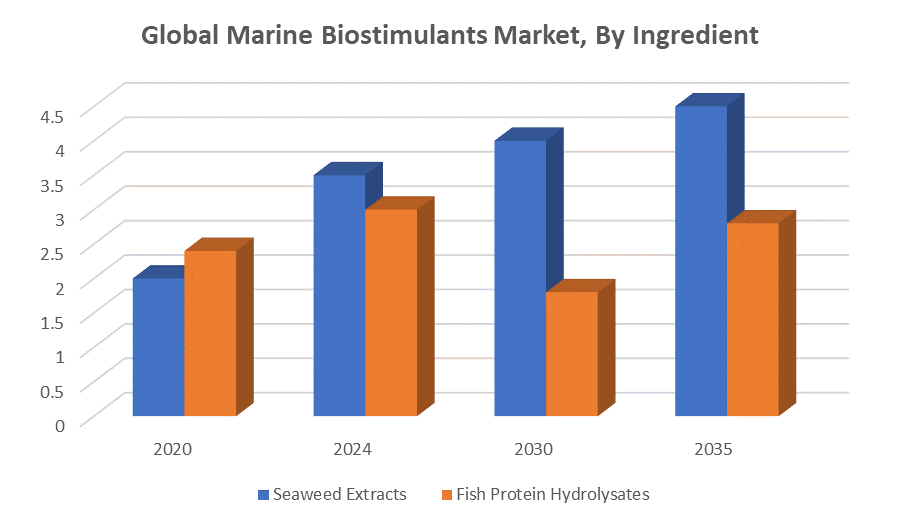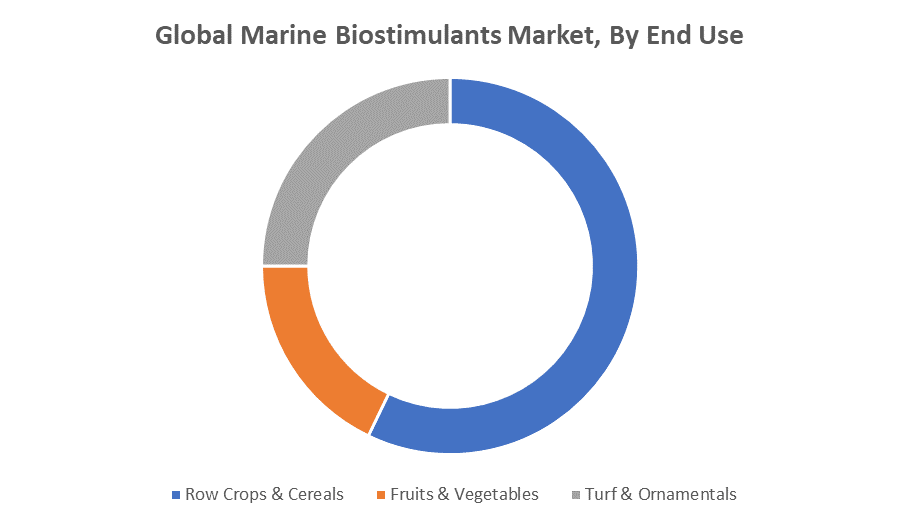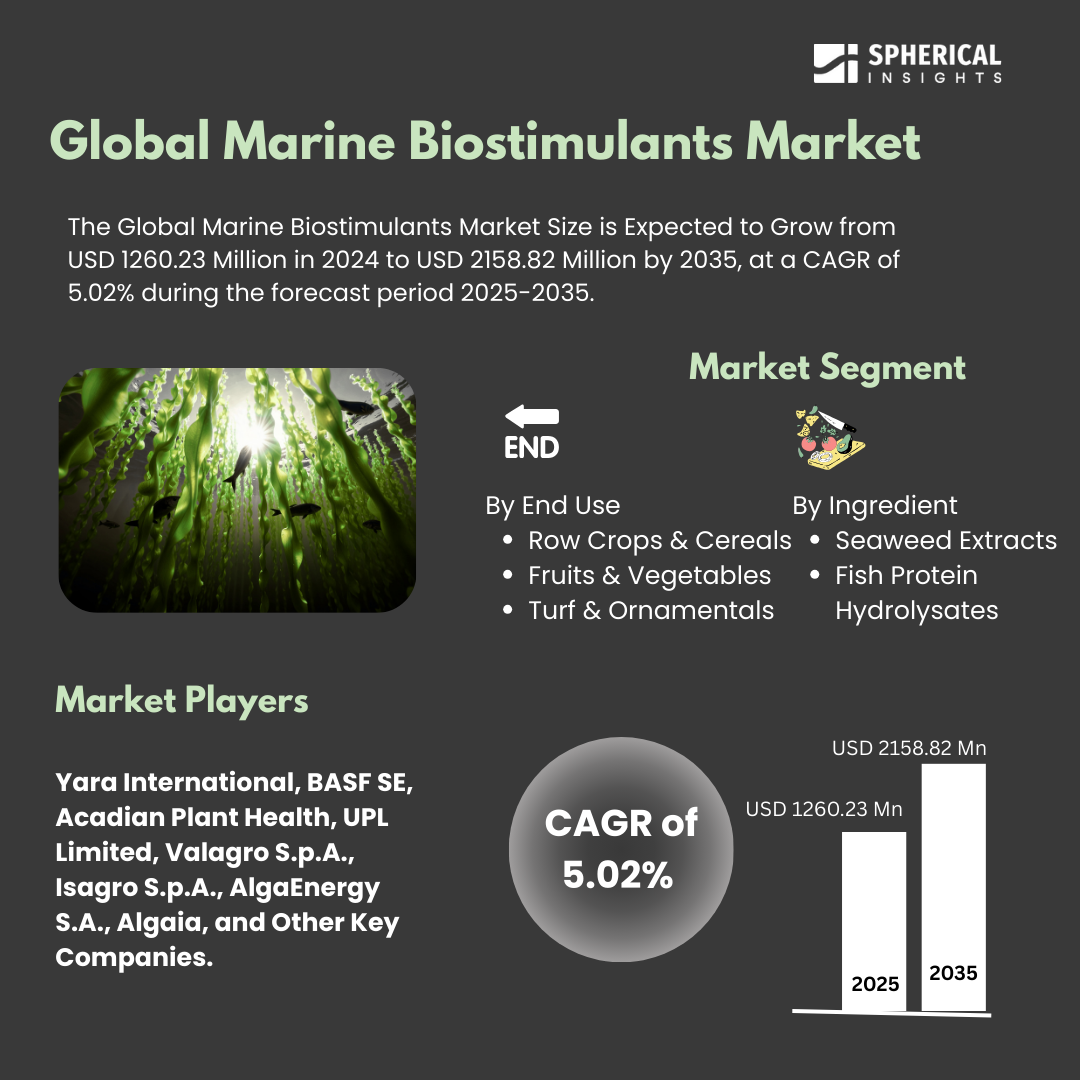Global Marine Biostimulants Market Insights Forecasts to 2035
- The Global Marine Biostimulants Market Size Was Estimated at USD 1260.23 million in 2024
- The Market Size is Expected to Grow at a CAGR of around 5.02% from 2025 to 2035
- The Worldwide Marine Biostimulants Market Size is Expected to Reach USD 2158.82 million by 2035
- Asia Pacific is expected to grow the fastest during the forecast period.
Marine Biostimulants Market
The marine biostimulants market focuses on products derived from marine sources such as seaweed, algae, and fish extracts that enhance plant growth and improve crop quality. These biostimulants function by activating natural processes within plants, boosting nutrient uptake, and increasing tolerance to environmental stresses. Unlike conventional fertilizers, marine biostimulants do not provide direct nutrients but support plant health and development, making them a key element in sustainable agriculture. The market includes various product types such as seaweed extracts, amino acids, and microbial formulations, which are used across diverse crop types. As awareness of sustainable farming practices grows, marine biostimulants are increasingly recognized for their ability to promote healthier plants and better yields while minimizing environmental impact. This emerging sector offers innovative solutions for modern crop management by enhancing plant vitality and resilience without relying on synthetic chemicals, thus contributing to more eco-friendly agricultural practices.
Attractive Opportunities in the Marine Biostimulants Market
- The use of genomics, bioinformatics, and biotechnology enables the development of more targeted and effective marine biostimulant formulations tailored to specific crop needs and environmental conditions.
- Growing demand in sectors beyond traditional agriculture such as horticulture, turf management, and forestry creates new market segments for marine biostimulants.
- Creating tailored biostimulant products that meet local environmental and crop-specific requirements enhances product efficacy and farmer adoption.
- Exploring and adopting eco-friendly harvesting methods and tapping into underutilized marine biomass resources can reduce production costs and environmental impact, boosting long-term market sustainability.
Global Marine Biostimulants Market Dynamics
DRIVER: Growing awareness about the harmful environmental effects
Growing awareness about the harmful environmental effects of synthetic agrochemicals encourages farmers to adopt natural alternatives like marine biostimulants. These products enhance crop productivity by improving nutrient uptake, stimulating plant growth, and boosting resistance to biotic and abiotic stresses such as pests, diseases, drought, and salinity. Additionally, rising demand for organic food products fuels the adoption of biostimulants, as they align with organic farming principles. Advances in biotechnology and research have also contributed to the development of more effective marine biostimulant formulations, broadening their application across various crops. Supportive government policies and regulations promoting eco-friendly agricultural inputs further accelerate market growth. Collectively, these factors create a favorable environment for the expansion of the marine biostimulants market worldwide.
RESTRAINT: Inconsistent efficacy of products
One major challenge is the inconsistent efficacy of these products, as their performance can vary significantly depending on crop type, environmental conditions, and application methods. This variability makes it difficult to establish standardized guidelines and can lead to hesitation among farmers when adopting biostimulants. Additionally, regulatory fragmentation poses obstacles, with differing definitions, classifications, and approval processes across regions complicating market entry for manufacturers. Supply chain constraints further limit market expansion, as the seasonality of seaweed and other marine raw materials, along with geographic and technological limitations in harvesting and processing, can cause fluctuations in product availability and quality. These factors collectively create uncertainty and impact the scalability of marine biostimulant products. To overcome these challenges, efforts are needed to standardize regulations, improve product consistency, and enhance supply chain efficiency, which are crucial for the sustainable growth of the marine biostimulants market.
OPPORTUNITY: Increasing integration of advanced technologies such as genomics and bioinformatics
One key opportunity lies in the increasing integration of advanced technologies such as genomics and bioinformatics, which enable the development of more targeted and effective biostimulant formulations. Additionally, expanding applications beyond traditional agriculture into horticulture, turf management, and even forestry offers new market segments. There is also growing potential in developing customized biostimulant blends tailored to specific crop needs and local environmental conditions, enhancing their effectiveness. Collaborations between marine biostimulant producers and research institutions can accelerate innovation and product development. Furthermore, rising consumer demand for clean-label and naturally derived agricultural products opens opportunities for branding and premium pricing. Finally, exploring underutilized marine biomass resources and sustainable harvesting methods can reduce production costs and environmental impact, positioning companies for long-term success in this evolving market.
CHALLENGES: Many farmers and end-users lack comprehensive knowledge
Many farmers and end-users lack comprehensive knowledge about how biostimulants work and their benefits compared to conventional fertilizers, leading to skepticism and slow adoption. Furthermore, limited scientific data and standardized testing protocols make it difficult to quantify and communicate the consistent value of these products. Another challenge lies in the complexity of marine biomass extraction, which requires specialized equipment and expertise to preserve bioactive compounds without degradation. This can increase production costs and affect product quality. Intellectual property issues and competition from synthetic alternatives also pose hurdles for manufacturers. Finally, supply chain logistics, including storage and transportation of sensitive marine biostimulant products, require careful management to maintain efficacy, adding operational complexities. Addressing these challenges through education, research, and innovation is essential to unlocking the full potential of the marine biostimulants market.
Global Marine Biostimulants Market Ecosystem Analysis
The global marine biostimulants market includes different groups working together. Raw material suppliers collect seaweed, algae, and other marine resources. Manufacturers turn these into biostimulant products that help plants grow. Researchers help improve these products by studying how they work. Distributors and stores sell the products to farmers, who use them on their crops. Government agencies make rules to keep the products safe and effective. All these groups cooperate to make sure marine biostimulants are available, useful, and safe, helping the market grow around the world.
Based on the ingredient, the seaweed extracts segment led the market with the highest revenue share and is expected to grow at a substantial CAGR over the forecast period

The seaweed extracts segment led the market with the highest revenue share because seaweed contains a wide range of natural bioactive compounds such as hormones, amino acids, vitamins, and minerals that play crucial roles in stimulating plant growth and improving crop health. These extracts enhance nutrient uptake, increase resistance to drought, salinity, and pests, and promote root development, leading to healthier and more resilient plants. Additionally, seaweed extracts are easy to apply, compatible with other agricultural inputs, and suitable for use in organic farming, which boosts their popularity among farmers.
Based on the end use, the row crops & cereals segment led the market with the largest revenue share and is expected to grow at a remarkable CAGR over the forecast period

The row crops & cereals segment growth is driven by the extensive cultivation of crops like wheat, corn, rice, and soybeans, which are staple foods globally. Marine biostimulants help improve the growth, yield, and stress resistance of these crops, making them highly valuable to farmers aiming for better productivity and sustainability. The large cultivated area and constant demand for higher crop output fuel the adoption of biostimulants in this segment. Additionally, increasing awareness about eco-friendly farming practices and the need to reduce chemical fertilizer use support the growing preference for marine-based biostimulants in row crops and cereals, making this segment a key contributor to market expansion.
Europe is anticipated to hold the largest market share of the marine biostimulants market during the forecast period
Europe is anticipated to hold the largest market share in the marine biostimulants market during the forecast period. This is largely due to the region’s strong focus on sustainable and organic farming practices, supported by strict government regulations that encourage the use of eco-friendly agricultural inputs. Additionally, Europe has well-established research and development infrastructure, promoting innovation in biostimulant products. High awareness among farmers about the benefits of marine biostimulants and growing demand for organic food further drive market growth. The presence of major biostimulant manufacturers and distributors in Europe also contributes to its dominant position, making the region a key hub for the adoption and expansion of marine biostimulants in agriculture.
Asia Pacific is expected to grow at the fastest CAGR in the marine biostimulants market during the forecast period
Asia Pacific is expected to grow at the fastest CAGR in the marine biostimulants market during the forecast period. This rapid growth is driven by the region’s large agricultural sector and increasing adoption of sustainable farming practices. Rising awareness about the benefits of marine biostimulants among farmers, along with government initiatives supporting organic and eco-friendly agriculture, further boost demand. Additionally, growing populations and the need to improve crop yields to ensure food security contribute to the expanding market. The presence of abundant marine resources and increasing investments in agricultural technologies also support the accelerated growth of marine biostimulants in the Asia Pacific region.
Recent Development
- In December 2024, Yara International unveiled its YaraAmplix biostimulant product line at the Biostimulant World Congress in Milan. This range, formulated from natural ingredients including seaweed and plant extracts, aims to enhance crop resilience against climate change and improve nutrient use efficiency. Yara has reported over 50% year-on-year sales growth in biostimulants since 2018.
- In October 2024, BASF SE partnered with Acadian Plant Health to expand its BioSolutions portfolio with seaweed-based biostimulants. This collaboration focuses on enhancing crop stress tolerance and promoting climate-smart agriculture, aiming to increase product availability in new markets
Key Market Players
KEY PLAYERS IN THE MARINE BIOSTIMULANTS MARKET INCLUDE
- Yara International
- BASF SE
- Acadian Plant Health
- UPL Limited
- Valagro S.p.A.
- Isagro S.p.A.
- AlgaEnergy S.A.
- Algaia
- Biolchim S.p.A.
- Algatech Ltd.
- Others
Market Segment
This study forecasts revenue at global, regional, and country levels from 2020 to 2035. Spherical Insights has segmented the marine biostimulants market based on the below-mentioned segments:
Global Marine Biostimulants Market, By Ingredient
- Seaweed Extracts
- Fish Protein Hydrolysates
Global Marine Biostimulants Market, By End Use
- Row Crops & Cereals
- Fruits & Vegetables
- Turf & Ornamentals
Global Marine Biostimulants Market, By Regional Analysis
- North America
- Europe
- Germany
- UK
- France
- Italy
- Spain
- Russia
- Rest of Europe
- Asia Pacific
- China
- Japan
- India
- South Korea
- Australia
- Rest of Asia Pacific
- South America
- Brazil
- Argentina
- Rest of South America
- Middle East & Africa
- UAE
- Saudi Arabia
- Qatar
- South Africa
- Rest of the Middle East & Africa





